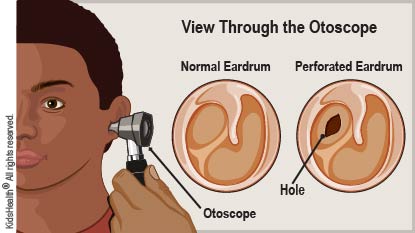Perforated Eardrum: How to Care for Your Child
A perforated eardrum (eardrum with a hole in it) usually doesn't cause long-term problems.


Injuries or infections can cause a hole in the eardrum, a condition known as a perforated (or ruptured) eardrum.
The rupture of an eardrum is often painful. Fluid may drain from the ear, and your child might feel dizzy or nauseated. Your child might have ringing or buzzing in the ear, and may not hear as well as usual.
In most cases, the hole closes on its own and hearing returns to normal within several months. Sometimes, surgery is needed to repair a persistent hole that hasn't healed.

-
If your health care provider has prescribed antibiotic ear drops or antibiotics by mouth, give them to your child as directed.
-
Don't use over-the-counter ear drops in your child's ear unless your health care provider tells you to do so.
-
Do not clean the inside of your child's ear. Never stick cotton swabs or other objects in the ear.
-
For ear pain, a medication may help:
-
For children under 6 months, you may give acetaminophen.
-
For children over 6 months, you may give acetaminophen OR ibuprofen, if recommended by your health care provider.
-
A warm compress held to the outside of the ear also may relieve pain.
-
Your child should avoid getting water in the ear until it heals:
-
For showering or bathing, gently place a waterproof earplug or cotton ball coated with petroleum jelly into the ear.
-
Your child should not swim or dive.
-
Your child should avoid forceful nose blowing, which can irritate the eardrum.

-
Keep all follow-up appointments with your health care provider.
-
If the eardrum does not heal within 2–3 weeks or the symptoms get worse, your child may need to be seen by an ear, nose, and throat (ENT) specialist.

Your child:
-
Has increased hearing loss.
-
Has worsening pain.
-
Develops vomiting.
-
Has a fever.
-
Has bleeding from the ear.
-
Continues to have drainage from the ear after 48–72 hours.